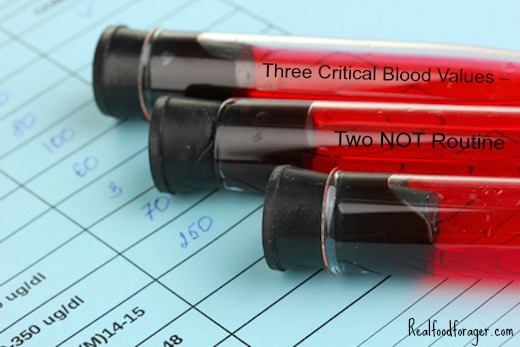In my previous post on blood testing, I outlined the problems with the standard reference ranges that most labs and doctors use. In this article I group three important and related blood tests. Sadly, two out of the three are not automatically included in the Comprehensive Metabolic Panel (CMP). Ask your doctor to order these two critical blood tests with your routine testing.
The Most Important Lab Value that is Not on a Routine Blood Test
There are some lab values that are very important to monitor that are not included on routine blood tests. One of these is insulin. This is perhaps the most important lab value to know and it is usually not ordered by the doctor.
However, let’s start with one of the usual tests in the Comprehensive Metabolic Panel (CMP) – glucose. The various tests included in the CMP may differ slightly between labs, but glucose is always included.
These tests should be performed after an 8 – 12 hour fast.
Glucose
Glucose is an important marker of how you are metabolizing carbohydrates (sugars). This is a good test, but it only shows your blood sugar at that particular moment in time. Blood sugar rises and falls in response to what you eat, how often you eat and how you metabolize sugar and carbohydrates. If your blood sugar is running on the high side, this test may not necessarily show it.
The typical range (Lab Corp) is 65 – 99 mg/dL. However the healthier range is much tighter – it is 80 – 90 mg/dL. Other labs show reference ranges for glucose that may be as low as 59 and as high as 109.
If your blood marker for fasting glucose is high you may be eating more carbohydrates and/or sugar than you should be.
If your marker is low, you may not be eating enough protein or fats. Eating protein causes the hormone glucagon to be released and this raises glucose levels in the blood (insulin lowers it). If you go too low in fat intake the body becomes totally reliant on sugar for energy and this can bring the glucose marker down too low.
Insulin
This is the most important blood marker for health. This is NOT included as routine CMP and needs to be specifically requested.
This goes hand in hand with glucose levels and should be included with all fasting glucose tests. You want to request this of your doctor.
If your glucose level is good (80 – 90mg/dL.), terrific! However, you still want to know how much insulin it’s taking for your body to have that healthy glucose level.
The typical reference range (Lab Corp) is 2.6 – 24.9 uIU/mL. The healthy range is 1 – 5 uIU/mL. Clearly, that’s a huge difference and is very misleading! If your fasting insulin is above 5 it indicates carbohydrate metabolism problems that are brewing. I would want to know that sooner than later. Wouldn’t you?
The average American consumes over 100 pounds of added sugar per year. Creating a lab reference range that goes so high justifies these poor food choices. This is not helpful. This outrageously high range is a reflection of just how unhealthy most lab patients (most Americans) are. See my previous post for information on how they come up with these lab reference ranges.
A fasting insulin level above 5 is an indicator that there is too much sugar consumption. The Life Extension Foundation advocates a fasting insulin of even less than 5.
This common reference range is clearly an indicator that most of the lab’s patients are consuming too many carbohydrates, which is a fact of the Standard American Diet (SAD).
Insulin lowers blood sugar levels. A fasting insulin level of 24 is huge. This value is assocaited with type 2 diabetes and insulin resistance. Excess insulin is clinically defined when levels are equal to or greater than 15 µIU/mL. Folks who have these levels are on the road to carbohydrate metabolism problems and a pro-inflammatory state. Additionally this indicates a fat storage problem.
You can see how important it is to know this fasting insulin level.
If your fasting insulin is above 5 you need to look at what carbs you may be over consuming and if you have carb cravings. Find out how to tame carbohydrate cravings here.
If you are trying to lose weight and you have a fasting insulin level above 5, it will be very difficult to lose weight.
If it happens to be low, you may be skipping meals and/or exercising too much. This can also throw your metabolism out of balance and so is also important.
Hemoblogin A1c
The HbA1c (also know as glycated hemoglobin) value is critically important. This also needs to be specifically requested as it is not included in the CMP. This is a measure of blood sugar levels over the previous 90 days. Measuring glycated hemoglobin is also used to monitor the effectiveness of therapy in diabetes by observing long-term serum glucose regulation, but should be used on everyone.
When blood glucose levels are high, glucose molecules attach to the hemoglobin in red blood cells. The longer hyperglycemia occurs in blood, the more glucose binds to hemoglobin in the red blood cells and the higher the glycated hemoglobin (HbA1c).
Once a hemoglobin molecule is glycated, it remains that way. A buildup of glycated hemoglobin within the red blood cell, reflects the average level of glucose to which the cell has been exposed during its life of 90 days.
The typical range (Lab Corp) is <5.7%. The healthier range is actually 4.7 – 5.2%. Some say the upper range can go up to 5.4%. You don’t want it too low as this would indicate low blood sugar.
If too high it is again indicating too much carbohydrates in the diet.
Problems with Too Much Sugar
Too much sugar in the RBC makes it more prone to sticking to other RBC’s and this is not good for circulation and/or energy production. Further down the line cardiovascular problems will develop.
Additionally, this study published in the British Journal of Cancer in March 2014, indicates that chronic hyperglycemia (increased blood sugar) correlates with the increased risk for cancer – and goes further to indicate that this risk is present, for those in the pre-diabetic state as well as for those people with “normal ranges” – for certain types of cancer.
Furthermore, this study published in Neurology in 2005 showed a link between higher HbA1c blood markers and brain shrinkage (atrophy). Here again, even though HbA1c levels of <5.7 are still considered within normal range, even these ranges showed a high rate of brain cell death. With higher HbA1c numbers the atrophy is worse.
According to Dr. Perlmutter in Grain Brain, HbA1c is,
… one of the greatest predictors of brain atrophy.
With the Sad American Diet full of processed sugars and carbohydrates, we are all at risk for diabetes, unless you make every effort to eat a low sugar, low carbohydrate diet.
Glucose, insulin and HbA1c all together reflect carbohydrate metabolism. Make sure you get all three and teach your doctor how to read them.
Some of the information for this post was gleaned from a lecture given by Jim Marlowe at the 2014 Weston Price Foundation Wise Traditions Conference.














